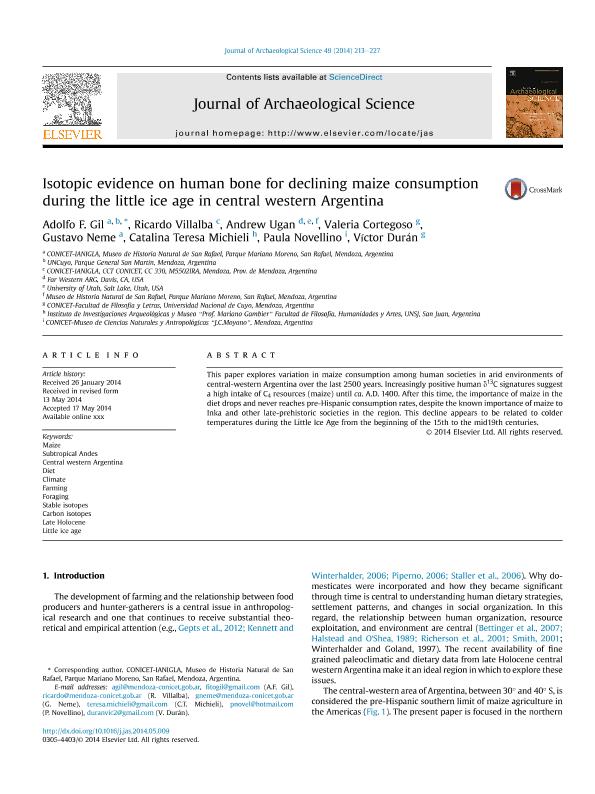Artículo
Isotopic evidence on human bone for declining maize consumption during the little ice age in central western Argentina
Gil, Adolfo Fabian ; Villalba, Ricardo
; Villalba, Ricardo ; Ugan, Andrew; Cortegoso, Valeria
; Ugan, Andrew; Cortegoso, Valeria ; Neme, Gustavo Adolfo
; Neme, Gustavo Adolfo ; Michieli, Catalina Teresa; Novellino, Paula Silvana
; Michieli, Catalina Teresa; Novellino, Paula Silvana ; Duran, Victor Alberto
; Duran, Victor Alberto
 ; Villalba, Ricardo
; Villalba, Ricardo ; Ugan, Andrew; Cortegoso, Valeria
; Ugan, Andrew; Cortegoso, Valeria ; Neme, Gustavo Adolfo
; Neme, Gustavo Adolfo ; Michieli, Catalina Teresa; Novellino, Paula Silvana
; Michieli, Catalina Teresa; Novellino, Paula Silvana ; Duran, Victor Alberto
; Duran, Victor Alberto
Fecha de publicación:
09/2014
Editorial:
Elsevier
Revista:
Journal of Archaeological Science
ISSN:
0305-4403
Idioma:
Inglés
Tipo de recurso:
Artículo publicado
Clasificación temática:
Resumen
This paper explores variation in maize consumption among human societies in arid environments of central-western Argentina over the last 2500 years. Increasingly positive human d13C signatures suggest a high intake of C4 resources (maize) until ca. A.D. 1400. After this time, the importance of maize in the diet drops and never reaches pre-Hispanic consumption rates, despite the known importance of maize to Inka and other late-prehistoric societies in the region. This decline appears to be related to colder temperatures during the Little Ice Age from the beginning of the 15th to the mid19th centuries.
Archivos asociados
Licencia
Identificadores
Colecciones
Articulos(CCT - MENDOZA)
Articulos de CTRO.CIENTIFICO TECNOL.CONICET - MENDOZA
Articulos de CTRO.CIENTIFICO TECNOL.CONICET - MENDOZA
Articulos(IANIGLA)
Articulos de INST. ARG. DE NIVOLOGIA, GLACIOLOGIA Y CS. AMBIENT
Articulos de INST. ARG. DE NIVOLOGIA, GLACIOLOGIA Y CS. AMBIENT
Citación
Gil, Adolfo Fabian; Villalba, Ricardo; Ugan, Andrew; Cortegoso, Valeria; Neme, Gustavo Adolfo; et al.; Isotopic evidence on human bone for declining maize consumption during the little ice age in central western Argentina; Elsevier; Journal of Archaeological Science; 49; 9-2014; 213-227
Compartir
Altmétricas



